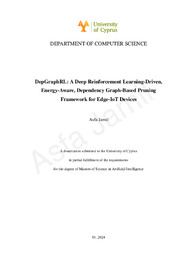| dc.contributor.advisor | Keravnou-Papailiou, Elpida | en |
| dc.contributor.author | Jamil, Asfa | en |
| dc.coverage.spatial | Cyprus | en |
| dc.creator | Jamil, Asfa | en |
| dc.date.accessioned | 2024-02-13T09:56:03Z | |
| dc.date.available | 2024-02-13T09:56:03Z | |
| dc.date.issued | 2024-01-08 | |
| dc.identifier.uri | http://gnosis.library.ucy.ac.cy/handle/7/66138 | en |
| dc.description.abstract | Recent technological advancements have revolutionized the role of the Internet of Things (IoT) in various commercial and industrial sectors, including applications in smart city, agriculture, healthcare, e-commerce, and industrial automation. Further, the landscape of IoT innovation has steered toward automation and real-time adaptability with the fusion of Artificial Intelligence knowledge in the domain of Deep Learning, Machine Learning and Reinforcement Learning. However, due to the small size of IoT devices, they often face computational capability and energy efficiency limitations. To overcome the computational constraints of IoT devices, the integration of cloud computing has been rigorously explored in different IoT applications. Though cloud computing provides powerful and robust computation servers to the IoT devices and allows offloading of various application tasks, the issue of high network and transmission latencies still persists. This necessitates the shift of paradigm towards the edge computing, transitioning consumer IoTs towards Edge-IoT devices. Though the Edge-IoT devices ensure the Quality of Services by leveraging computation near to IoT devices, the computation of complex tasks on battery constraint Edge-IoT devices requires efficient and intelligent energy management schemes, especially in the context of operating Deep Neural Networks, such as Convolutional Neural Network (CNN), for image classification.
A practical and renowned approach to reduce the energy consumption of Edge-IoT devices for operating CNN models is to deploy efficient energy-aware, less structurally complex neural network models on Edge-IoT devices using \textit{network pruning}. However, this deployment comes with various constraints. The first constraint revolves around the accurate measurement of energy consumption in any baseline CNN model. The traditional methods of estimating energy consumption by using theoretical formulas often fall short considering practical scenarios where different natural factors also contribute in evaluation methods. Thus, the evaluation of energy consumption requires empirical measurements methods alongside the theoretical approaches. The second constraint is the limitations of existing pruning methodologies, particularly the lack of generalizability across various neural network architectures and the complexities introduced by structural coupling in pruning processes. The third and final constraint delves into the optimization challenges in pruning CNN models for Edge-IoT devices, considering the multifaceted nature of variables within a dynamic environment, such as layer count, energy consumption, and accuracy requirements. These challenges necessitate a novel approach, combining empirical energy measurements with advanced pruning techniques and optimization strategies.
To resolve these constraints, this thesis proposes a novel DepGraphRL framework to optimise the CNN models on Edge-IoT devices. The proposed framework utilizes Deep Reinforcement Learning (DRL) to provide an energy-aware, fully automated, and generalizable layer-wise pruning technique for neural networks by employing DepGraph for structural pruning and empirical methods for energy consumption calculation of CNNs at edge devices. The proposed framework considers the pruning of neural networks as a Markov Decision Problem. It utilizes an Advantage Actor-Critic algorithm for optimal policy training to decide which layers to prune while balancing available energy and the required accuracy tradeoff. A unique feature of the framework is the utilization of a dependency graph-based structural pruning approach, i.e. DepGraph; this approach ensures generalizability of the same pruning technique to the different neural networks in an automated fashion and also handles issues of structural coupling while preserving the original model architecture and Performance. The empirical methods used in calculating the energy consumption of neural networks on Edge-IoT devices support the applicability of the proposed framework in real-world applications compared to theoretical methods.
Using different pruning ratios and feature importance ranking techniques, the proposed framework has been extensively evaluated on different neural network architectures like ResNet-18, VGG-19, and MobileNet. Compared to the baseline Depgraph pruning method, the proposed DepgraphRL framework reduces overall energy consumption while obtaining accuracy comparable to the baseline neural network models. This shows the effectiveness of the proposed energy-aware framework in optimizing the performance of neural networks in energy-constraint environments by providing energy-efficient pruned architectures of baseline CNN models with comparable accuracy to the baseline. | en |
| dc.language.iso | eng | en |
| dc.publisher | Πανεπιστήμιο Κύπρου, Πολυτεχνική Σχολή / University of Cyprus, Faculty of Engineering | |
| dc.rights | CC0 1.0 Universal | * |
| dc.rights | info:eu-repo/semantics/openAccess | en |
| dc.rights | Open Access | en |
| dc.rights.uri | http://creativecommons.org/publicdomain/zero/1.0/ | * |
| dc.title | DepGraphRL: A Deep Reinforcement Learning-Driven, Energy-Aware, Dependency Graph-Based Pruning Framework for Edge-IoT Devices | en |
| dc.type | info:eu-repo/semantics/masterThesis | en |
| dc.contributor.committeemember | Vassiliou, Vasos | en |
| dc.contributor.committeemember | Ashraf, Nouman | en |
| dc.contributor.department | Τμήμα Ηλεκτρολόγων Μηχανικών και Μηχανικών Υπολογιστών / Department of Electrical and Computer Engineering | |
| dc.subject.uncontrolledterm | DEEP REINFORCEMENT LEARNING | en |
| dc.subject.uncontrolledterm | DEPGRAPH | en |
| dc.subject.uncontrolledterm | ENERGY EFFICIENCY | en |
| dc.subject.uncontrolledterm | IOT | en |
| dc.subject.uncontrolledterm | EDGE-IOT DEVICES | en |
| dc.subject.uncontrolledterm | ENERGY AWARE PRUNING | en |
| dc.subject.uncontrolledterm | STRUCTURAL PRUNING | en |
| dc.subject.uncontrolledterm | NEURAL NETWORK | en |
| dc.author.faculty | Πολυτεχνική Σχολή / Faculty of Engineering | |
| dc.author.department | Τμήμα Ηλεκτρολόγων Μηχανικών και Μηχανικών Υπολογιστών / Department of Electrical and Computer Engineering | |
| dc.type.uhtype | Master Thesis | en |
| dc.contributor.orcid | Keravnou-Papailiou, Elpida [0000-0002-8980-4253] | |
| dc.contributor.orcid | Jamil, Asfa [0009-0009-1190-9117] | |
| dc.contributor.orcid | Vassiliou, Vasos [0000-0001-8647-0860] | |
| dc.contributor.orcid | Ashraf, Nouman [0000-0002-0164-8031] | |
| dc.gnosis.orcid | 0000-0002-8980-4253 | |
| dc.gnosis.orcid | 0009-0009-1190-9117 | |
| dc.gnosis.orcid | 0000-0001-8647-0860 | |
| dc.gnosis.orcid | 0000-0002-0164-8031 | |


